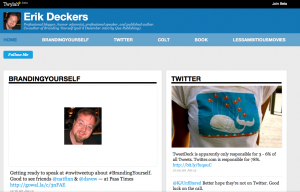Linkedin is an underutilized social media tool.
Linkedin is one of the best social media tools out there to connect to your market. For business to business marketing, you will probably find the people are you looking for on Linkedin. Before you do though, consider some of the Does and Don'ts of how to use it.
Don't: Use Your Work or Primary Home Email as Your Public Email
Get a Gmail, Yahoo or Hotmail account, unless you really like spam with your email. LinkedIn provides some protection to your email address, but it does give your email to first degree connections and the owners of groups you join.
Do Understand How LinkedIn Search Works
LinkedIn has millions of users. LinkedIn's search system is critical because it is what helps you find people and what powers the "people you may know" tool. The search tool is limited to:
- First level connections - your friends.
- Second level connections - your friend's friends.
- Third level connections - your friend's friends friends.
- People in groups with you
- A random sample of the rest of the database - and you do not get to see names.
In short: the more connections you have, the easier is to find people you are not connected to.
Do Have a Strategy
Quantity over Quality
The idea here is to connect with as many people as possible so you have access to as many LinkedIn users as possible. This generally means accepting connections from anyone who wants to connect with you. If you are a marketer, serial networker or recruiter, then the quantity should trump quality.
Quality over Quantity
If you don't need max our your visibility of LinkedIn's database, then the best way to use LinkedIn is to focus on quality. Connect with people that you know or who have a reason (beyond being a prospect) to know you. If you do purue quality, you should connect with a few "superconnectors" (people with thousands of connections) to gain access to more people in LinkedIn's database. It will be very hard to find people you know if you only can see 23,000 people compared to 453,000 people.
Do: Join groups
Groups allow you to find people with simmilar interest quickly. Joining in discussion is a great way to meet new people.
Don't Spam Groups
On LinkedIn there are two kinds of spam: blatant self promoting advertisements and blatant attempts to get more connections. Take a minute to look at a discussion group before your post a message and make sure the group has posts like the one you want to make.
Do: State that you are open to connections if you are.
If you want to grow your network quickly, tell people that you are an "open networker," or even become a LION (LinkedIn Open Networker).
Don't break Outlook with your fabulous name.
LinkedIn allows people to download their freinds and their friend's email addresses. If you make a fancy name like ">>>Bob "The NetworkGuru" Smith<<<" it will make a first impression. But the second impression will be that you can't be found in outlook because your first name doesn't start with ">" it starts with "B."
Paul is the President of Professional Blog Service. PBS works with clients making strategic investments into business blogging, social media and search engine optimization.





 Search your name: you’ll find social networks and social news sites own it.
Search your name: you’ll find social networks and social news sites own it.